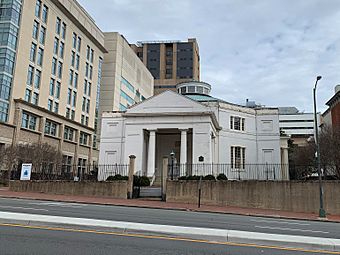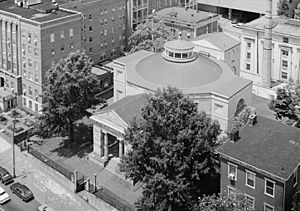Monumental Church facts for kids
|
Monumental Church
|
|

Monumental Church, 2019
|
|
| Location | 1224 E. Broad St., Richmond, Virginia |
|---|---|
| Built | 1812–1814 |
| Architect | Robert Mills |
| Architectural style | Greek Revival |
| NRHP reference No. | 69000326 |
Quick facts for kids Significant dates |
|
| Added to NRHP | April 16, 1969 |
| Designated NHL | November 11, 1971 |
Monumental Church is a historic church in Richmond, Virginia, that is no longer used for regular services. It was designed by the famous architect Robert Mills and is a well-known example of Greek Revival style, which was inspired by ancient Greek temples.
The church was built between 1812 and 1814 as a memorial to 72 people who died in a terrible fire at the Richmond Theatre on December 26, 1811. The building has two main parts. Underneath the main church is a crypt, which is a stone chamber holding the remains of those who died in the fire. The church itself is an octagon, meaning it has eight sides.
Today, Monumental Church is a National Historic Landmark, which means it is officially recognized by the United States government as an important historical site.
Contents
A History of the Site

The land where Monumental Church stands has a long and interesting history. Long before the church was built, the site was chosen for America's first Academy of Fine Arts and Sciences. However, the American Revolutionary War stopped those plans.
In 1786, the first theater in Richmond was built on this spot. It was a simple, barn-like building.
The Virginia Ratifying Convention
In 1788, a very important meeting was held in the theater. This was the Virginia Ratifying Convention, where leaders gathered to decide if Virginia should approve, or "ratify," the new United States Constitution.
Many famous historical figures were there, including:
- James Madison, who would later become the fourth U.S. President.
- John Marshall, who became the Chief Justice of the Supreme Court.
- Patrick Henry, a famous speaker known for his "Give me liberty, or give me death!" speech.
The Richmond Theatre Fire
The first theater burned down in 1802. A new one, called the Richmond Theatre, was built to replace it. On December 26, 1811, a terrible fire broke out during a performance. The fire spread quickly, and sadly, 72 people died in the tragedy.
To honor the victims, city leaders decided to build a church on the site as a monument. Chief Justice John Marshall led the effort to build it.
Designing a Special Church
The committee in charge of the new church hired Robert Mills to design it. Mills was the first important architect born in America. He also designed the famous Washington Monument in Washington, D.C. Mills was known for being very careful about making his buildings fireproof.
The church he designed was unique. It has a large porch, called a vestibule, at the entrance. The main part of the church is an octagon with a low, rounded roof called a dome. Inside, a balcony runs along the walls, offering more seating.
Famous people who attended the church included Chief Justice John Marshall and his family. The foster parents of the writer Edgar Allan Poe were also members. When the Marquis de Lafayette, a French hero from the Revolutionary War, visited Richmond in 1824, he attended a service at Monumental Church.
The Church in Modern Times
Over the years, as Richmond grew and people moved to different neighborhoods, the church's congregation became smaller. In 1965, it was closed for regular services and was taken over by the Historic Richmond Foundation.
In 2004, the church went through a major restoration. The monument honoring the 72 fire victims was carefully recreated. The original victims' remains are still resting peacefully in the brick crypt beneath the church floor.
A documentary film called Saving Grace-Resurrecting American History was made about the project. It shows how workers used modern technology like laser scanners to measure the original monument. This data was sent to stonecutters in Ireland, who carved a new 7,000-pound monument that is an exact copy of the original.
Today, Monumental Church is open for tours and special events. It stands as a beautiful and solemn reminder of Richmond's history.
See also



